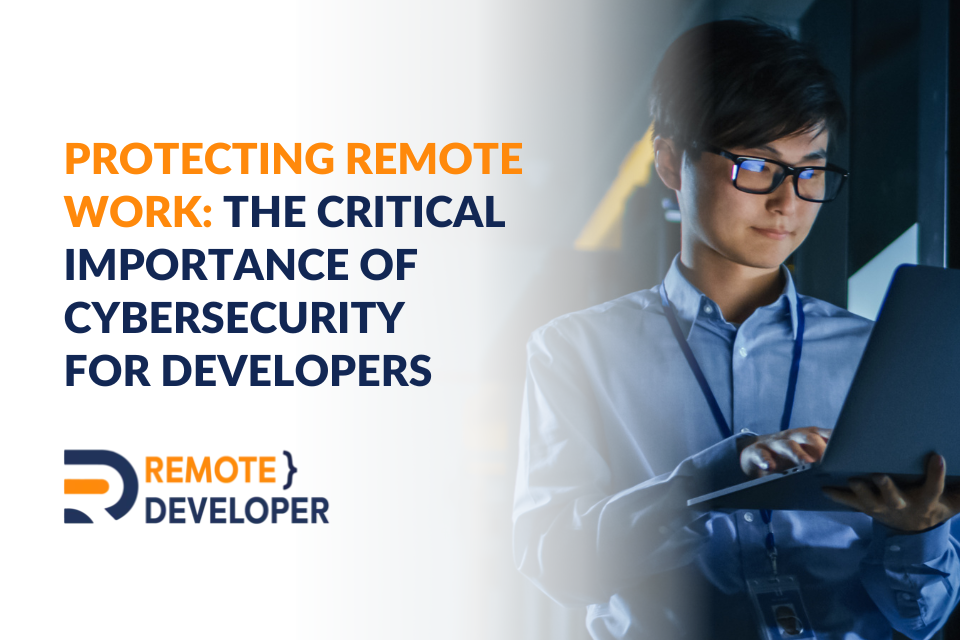As remote work continues to gain momentum, particularly in the tech industry, the importance of cybersecurity for remote developers has never been more critical. The flexibility and convenience of remote work come with unique challenges, especially regarding securing sensitive data and maintaining operational integrity.
Understanding and implementing robust cybersecurity measures is essential for remote developers and the organisations that employ them to safeguard against ever-evolving cyber threats.
This article delves into the key cybersecurity risks remote developers face, essential practices to mitigate these risks, and the tools and technologies that can help create a secure remote working environment.
Cybersecurity Risks for Remote Developers
Remote developers face various cybersecurity risks that can compromise both their work and the sensitive data they handle. Without the protection of a centralised, secure office network, remote developers are particularly vulnerable to the following threats:
- Phishing Attacks. Remote developers rely heavily on email communication, making them prime targets for phishing attacks. Hackers use sophisticated methods to trick developers into revealing sensitive information or installing malicious software.
- Unsecured Networks. Working from various locations, including coffee shops, airports, and co-working spaces, increases the likelihood of connecting to unsecured networks. These open networks are breeding grounds for cyberattacks, allowing malicious actors to intercept data transmissions easily.
- Weak Passwords and Authentication. Weak passwords and inadequate authentication mechanisms can expose remote developers to unauthorised access. Without proper password management practices, developers risk having their credentials compromised.
- Inadequate Encryption. Developers often share and store sensitive data. If these data transfers are not encrypted, they are vulnerable to interception by cybercriminals.
- Malware and Ransomware. Remote developers, especially those using personal devices, are at a higher risk of malware and ransomware attacks. These attacks can lead to significant data loss and operational disruption.
Essential Cybersecurity Practices
To combat these risks, remote developers must adhere to essential cybersecurity practices designed to protect their work and the integrity of the systems they access. The following practices are critical for enhancing cybersecurity for remote developers.

- Use Strong, Unique Passwords. Implementing strong passwords for all accounts is fundamental. Developers should use password managers to generate and store complex passwords, ensuring they are not reused across different platforms.
- Enable Two-Factor Authentication (2FA). 2FA adds an extra layer of security and can prevent unauthorised access even if passwords are compromised. Remote developers should enable 2FA on all critical accounts.
- Secure Networks with VPNs. Virtual Private Networks (VPNs) encrypt internet traffic, making it difficult for hackers to intercept data. Remote developers should always use a VPN when connecting to public or unsecured networks.
- Regularly Update Software and Systems. Regular software and system updates are key to preventing cyberattacks. Developers should enable automatic updates to ensure they have the latest security patches and features.
- Backup Data Regularly. Routine data backups help protect against data loss due to hardware failures or cyberattacks. Developers should back up their work to encrypted cloud storage or external drives to ensure it’s secure and recoverable
5 Tools and Technologies
Several tools and technologies can assist in maintaining robust cybersecurity for remote developers. Here are some of it:
- Password Managers. Tools like LastPass or Dashlane help developers manage their passwords securely by generating and storing complex passwords.
- VPN Services. Services like NordVPN and ExpressVPN offer reliable VPN connections that protect developers when accessing the internet from unsecured networks.
- Antivirus and Anti-Malware Software. Solutions like Bitdefender and Malwarebytes provide real-time protection against various cyber threats, including viruses, malware, and ransomware.
- Encryption Tools. Tools like VeraCrypt and BitLocker ensure that sensitive data is encrypted, making it unreadable to unauthorised users.
- Remote Access Security Tools. Tools like Cisco AnyConnect or TeamViewer offer secure remote access solutions, ensuring developers can safely connect to their work environments.
Read These Related Articles
Creating a Culture of Security
While tools and practices are essential, creating a security culture within an organisation is equally important. A security-focused culture encourages remote employees to prioritise cybersecurity in their daily operations. This culture can be fostered by:
- Training and Education. Regular training on cybersecurity for remote developers is vital. Training sessions should cover the latest threats and best practices for maintaining security.
- Clear Security Policies. Organisations should establish and enforce clear security policies that outline the expected cybersecurity practices for remote developers.
- Encouraging Reporting. Developers should feel comfortable reporting potential security issues or breaches without fear of retribution. An open reporting environment helps address vulnerabilities quickly.
Regular Security Audits. Conducting regular security audits can identify potential weaknesses in remote teams’ cybersecurity practices, allowing for timely remediation.
Legal and Compliance Implications
The legal and compliance implications of inadequate cybersecurity are significant. Remote developers and the organisations that employ them must comply with various regulations and standards, such as GDPR or HIPAA, depending on their industry and location. Non-compliance can result in hefty fines, legal actions, and reputational damage.
- Data Protection Regulations. Remote developers handling sensitive data must ensure compliance with data protection regulations. This includes implementing adequate encryption, secure data transfer methods, and data minimisation practices.
- Intellectual Property Protection. Developers often work with proprietary code and intellectual property. Ensuring these assets are protected from cyber threats is essential to maintaining a competitive edge and avoiding legal complications.
- Client Confidentiality. Maintaining client confidentiality is paramount for remote developers working on client projects. Failure to protect client data can lead to loss of trust and legal repercussions.
Conclusion
In an increasingly remote world, cybersecurity for remote developers is not just necessary but a critical component of successful and secure remote operations. Through this, they can protect themselves and the organisations they work for from cyber threats.
With that said, it’s time to assess and fortify your cybersecurity measures to ensure your remote operations are secure and compliant. So, don’t wait until it’s too late—take action today to protect your sensitive data and maintain your operational integrity. Contact us today!

